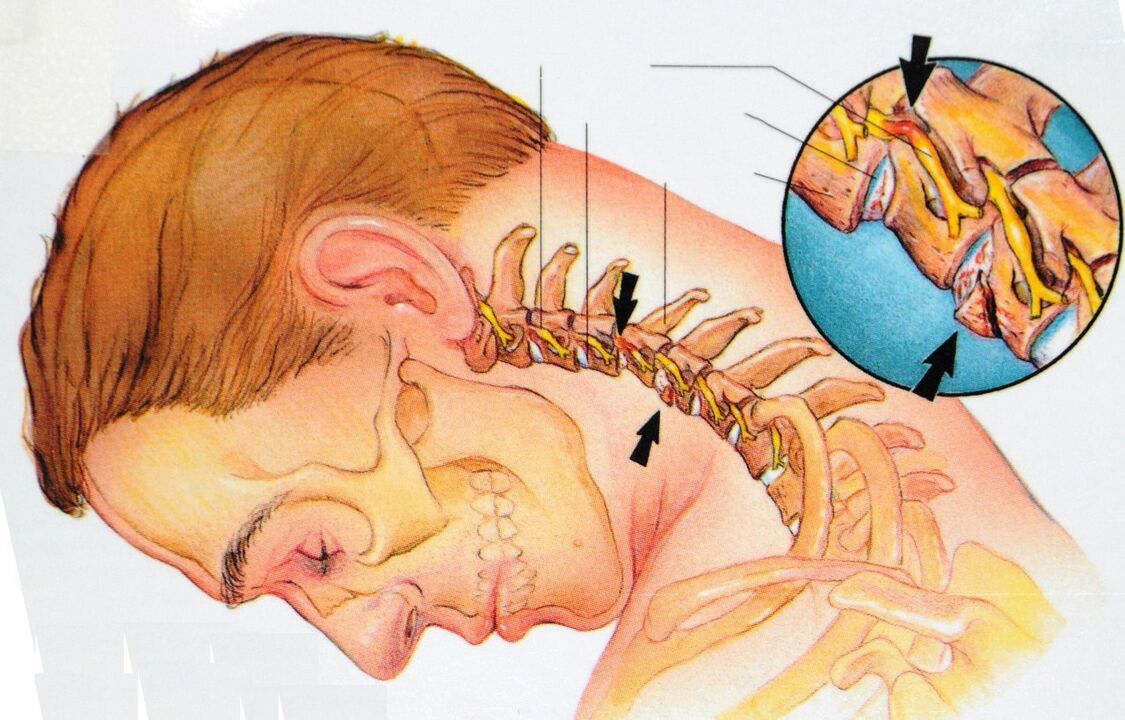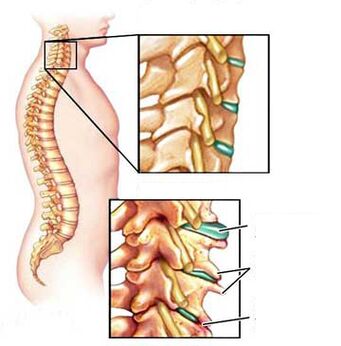Neck pain is a worrying sign.Maybe this is just a supernatural and you just have to relax and relax.But what if the pain is associated with the cervical spine?It is important to carefully examine symptoms and treatment, because complications can affect the most important organ - the brain.
What is cervical osteochondria
The cervical spine osteochondria is a degenerative disease of the bone-heavy body.This leads to the destruction of cervical intervertebral discs, the development of the bone tissues of the vertebrae, the formation of increases on their surfaces.

The cervical spine consists of seven vertebrae, the first of which is articulated with the skull.The anatomical and functional unit of the spine is the part of the spine.It is a common complex due to the spine.The complex consists of two vertebrae, the intervertebral disc, the articular surfaces of the vertebrae (appearance), nerve, joints and muscles.
Osteochondria begins with damage to the intervertebral disc and affects all surrounding tissues.Over time, the process leads to a violation of its industrial spine as a whole.With the development of osteochondry, intervertebral disc hernias, nerve and blood vessel compression can form.
Pathological processes in the intervertebral disc are carried out four stages: nutrition, weakening of the joints, disc damage and nerve compression.
Stage 1.The diet and metabolism of the intervertebral disc are violated.Due to the characteristics of the structure, the discs are eaten only during movement.If not, changes in dystrophic tissues begin: the disc is starving and dehydrated.Water loss leads to the fact that the intervertebral disc cannot perform the depreciation functions.The load on the fibrous ring is intensified, cracks and tears appear.There may be little pain right now.
Stage 2.In the second stage, the vertebral section link appears.The connection becomes pathologically mobile.The pathological process on the disc is deteriorated, the hernia begins (prolapse) - leak the core of the pulp through cracks in the fibrous ring.Pain becomes magazine.
Stage 3.In addition, the intervertebral disc is completely damaged.The core of the album of the disc exceeds the fibrous ring.The resulting hernia can violate nerve roots.The inflammatory process is developing.This is manifested by the deterioration of pain, the so -called radical syndrome.
Stage 4.In the fourth stage, the defeat affects the nearby fabrics.It is possible to compress the radical artery, which leads to the lack of blood supply to the spinal cord.As a result, the spine can be completely immobilized.

First signs and main symptoms
At the beginning of the development of cervical osteochondicity, discomfort, restriction of movement, throat pain.Often this does not pay attention.
Over time, the pain is intensified, pains, burning, head, neck, shoulders, shoulders that hurt - perhaps this develops the spine syndrome.The artery is squeezed or spasmodic, the blood flow is disturbed.
In 1-2 stages of cervical osteochondicity, ophthalmological problems associated with spasm in the vessels often occur.Dark eyes, flickering, the appearance of the "flies", colored spots in front of the eyes - all of which are symptoms of osteochondry.
The most common symptoms of cervical osteochondicity:
- Migraines, dizziness, nausea and cough.
- Hearing, ear pain, face.
- Kinetic disorders in the hands, legs.The sensitivity of the skin to the head can be a gap.
- Hand pain.If a nervous spine is stinging, then the entire area in which it sends impulses can damage or "fall".
In addition to the above symptoms, you can distinguish three main pain syndromes, accompanying cervical spine.The syndrome is a whole complex of symptoms.Determination of the main pain syndrome is important, since the entire therapeutic regimen is precisely made in the elimination of pain.And it is impossible to eliminate it without knowing the origin.
Mifosacological syndrome- Pain in skeletal muscles and neighboring fascia.The violation is associated with overload, in which spasm, hypertension, painful nodes in the muscles (activation points) occur.
Rook syndrome- The pain caused by the prolonged compression of the roots of the spinal nerve.The process of forming hernia for spine osteochondria leads to a nerve fiber sting and subsequent inflammatory reaction.The pain spreads along the nerve.
Facade syndrome- Pain in vertebrates.The vertebrae from the second cervical have articular processes, which are interconnected with arched (sides) joints.With osteochondria, the intervertebral discs are destroyed, their height decreases and this leads to the fact that the joints of the joints of the toxed joints are in constant intensity.This causes pain.In addition, the pain increases by the end of the day, especially with a long -term compulsory position.
The causes of osteochondry in cervical spine
One of the main causes of osteochondicism is the evolution of the spine into a high vertical load.People's ancestors walked four legs, as were other mammals.They did not suffer from osteochondria, since in the horizontal position of the criminal of intravenous pressure it is half as it is in the vertical.According to the patterns of evolution, the transition to the straightening did not occur long ago, and the spine simply did not have time to adapt to a high vertical load.Thus, along with Sealining, a person also acquired diseases of the musculoskeletal system.
An even more vulnerable neck of a person makes his structure.The part of a person's cervix consists of seven small mobile vertebrae, which are formulated by the type of children's pyramid.This design can hardly be called firm outside the rest.In addition, the muscle frame in this zone is weak and the loads can be high - all make the neck vulnerable.Any injury is full of consequences.Even if the damage was in another spine, the redistribution of the load can cause osteochondria.
Another factor is aging.The formation of the fabric of the skeleton and cartilage ends by 21 and then the irreversible aging process (degeneration) begins.Cartilage foods are performed only due to diffusion and if the intervertebral disc receives no nutrients, it begins to collapse gradually.
In addition, the development of cervical osteochondicity contributes to:
- Autoimmune diseases.They include their own body cells in the pathological process of destruction of cartilage tissue.
- Infections, hormonal failure, deceleration of metabolism - all of these circulatory disorders can also serve as factors for the development of osteochondination.
- A sedentary lifestyle, working conditions under which a person spends most of the time in a forced static position.
- High loads leading to injuries can lead to compression.
- Genetic defects associated with the weakness of the musculoskeletal system and the inferiority of the cartilage fabric.
The vertebral channel in the cervical spine is very narrow, so high loads, any violation or injury can lead to spinal cord compression.And this is very dangerous.
In addition, a large number of nerve ending and blood vessels pass through this area.If the blood stops flowing into the brain in the appropriate tumor, a stroke may occur.
Diagnosis
In the main diagnosis of cervical osteochondicism, the doctor collects the patient's history.It discovers this and how it hurts, with what intensity, with load or in rest, at what time of the day it hurts stronger, or the cervical spine has happened.
During the throat examination, the doctor feels cervical vertebrae and muscles, lymph nodes.Evaluates the volume of movements, excludes or confirms rooser syndrome.
After that, a laboratory diagnosis is prescribed to rule out autoimmune diseases: a general blood test, ESR, rheumatoid agent, HLA B27 antigen.
The main role in diagnosis is given in radiography, computed tomography and magnetic resonance imaging.
RadiographyIt helps to evaluate the status of bone structures, soft tissues and cartilage in the pictures do not appear.In order to visualize these structures, the contrast is introduced: angiography, discography, myelography.
Computed tomography (CT).This method also uses the principle of x -ray, but using a computer processing, you can get a series of longitudinal and transverse images in which you can see bones and cartilage.
Magnetic resonance imaging (MRI).It is a "gold standard" in the diagnosis of pathologies, including cartilage and soft tissue.MRI gives an idea not only of the structure of the organs and tissues, but also to their function.In the case of frequent complication, there is a spine hernia.Magnetic resonance imaging allows you to diagnose the hernia formation process in the early stages.
Treatment
Treatment of cervical spine osteochondry is reduced in conservative methods.Initially, the pain syndrome is removed and then various procedures are prescribed.But in the most extreme cases, when the pain does not pass for more than three months and the drugs do not help, surgery becomes the only way out.
Non -surgical methods of treatment
Osteochondria has hit the bone -anstal system for more than a year and therefore treatment will take time.Patience must be acquired.Conservative treatment tasks:
- Eliminate pain.
- Remove inflammation.
- Reset the functions of spine roots.
- Enhance the corset and muscle joints.
Conservative treatment includes pharmaceutical therapy and physiotherapy.Fridays help relieve pain during deterioration and physiotherapy - to begin the processes of the body.
During severe pain with a radical syndrome, the so -called "blockade" is performed: The drug is administered in immediate proximity to the inflammatory spine of the spinal nerve.
Physiotherapeutic therapy is based on natural and artificially recreated natural factors: cold, heat, electricity, magnetic radiation, laser and more.Special devices, devices, manual methods are used for their reconstruction.
Laser treatment- Biological activation of regeneration processes of intervertebral discs.The body begins to self -head.
Putotherapy (PRP treatment)- Plasma injections isolated from the patient's blood.The creature is rich in platelets, growth factors, hormones.After the injection, local immune begins, the regeneration processes begin.
Acupuncture- Stimulation of nerve endings with special needles.It improves metabolism in affected areas, relieves pain.
Impact treatment- Exposure to high frequency waves.It allows you to start natural recovery processes.
Kinesithine- Motion therapy.It can be active (exercise treatment) and passive (massage, attraction).LFK enhances back muscles, attraction relieves tension and pain.It is selected taking into account the individual characteristics of the patient.
Manual treatment and massage- Exposure to soft tissues and joints in order to restore balance to the body and synchronization of procedures.Return mobility and eliminate pain.
Filming- Looking at special rocks on the skin in places where it is necessary to affect the stretching receptors and muscle compression.Can relax and increase tone.
During the acute pain, the patient is recommended to wear special bandages and collars in the throat.
The positive effect of conservative treatment is achieved in 2-3 months.If there is no effect, the patient is recommended.
Surgical methods of treatment of osteochondicity
The function in the case of cervical osteochondrication is an extreme measure for which special indications are required.The operation is recommended if:
- Pain cannot be removed with therapeutic therapy for more than 3 months.
- There is a hernia of the intervertebral disc.
- The sensitivity to the end disappears
Postoperative rehabilitation also requires time and may include therapeutic treatment.
Cervical osteochondria is a complex degenerative disease.You can't deal with it.Such serious violations in the musculoskeletal system can lead to disability.The pain in the throat can be chronic, the osteochondria will spread to different parts of the spine.Early prevention can prevent the development of this disease.
Prevention
Daily physical activity is required to maintain the health of the cervical spine.Intervertebral disc food occurs in motion, so it is extremely necessary.It is important that loads are optimal and normally.
If the job is related to continuous finding in static position, a warm periodic is required.And at home after a business day you can lie on your back on a flat surface for some time, putting a cylinder under the neck.This method will help restore the cervical bending of the spine, to remove muscle intensity.
In the prevention of cervical osteochondry, the right posture during sleep is important.If a person in the morning rises with pain in his throat, then the muscles had no time to relax and recover.Here, an orthopedic pillow, which is selected individually, will help for 3-5 years.



























